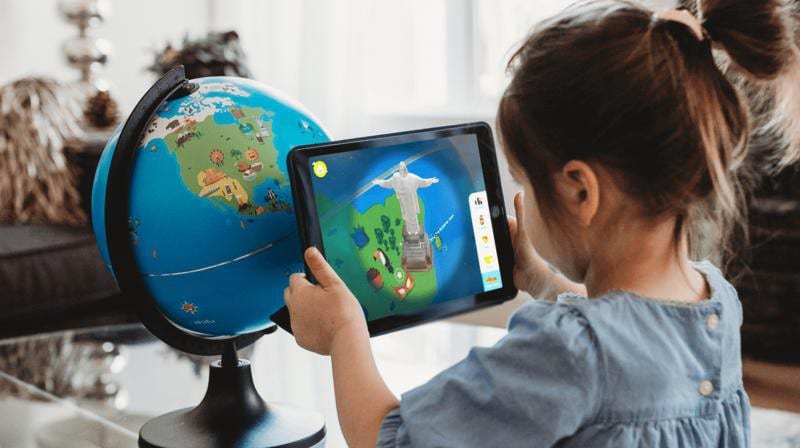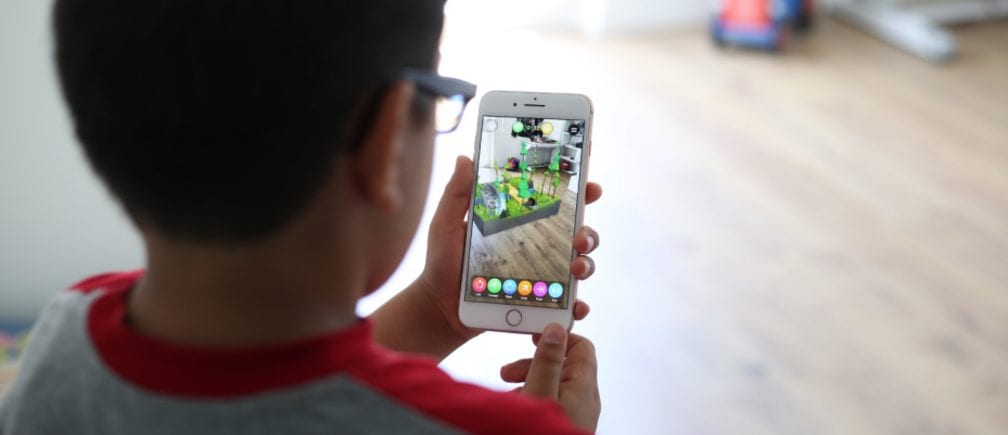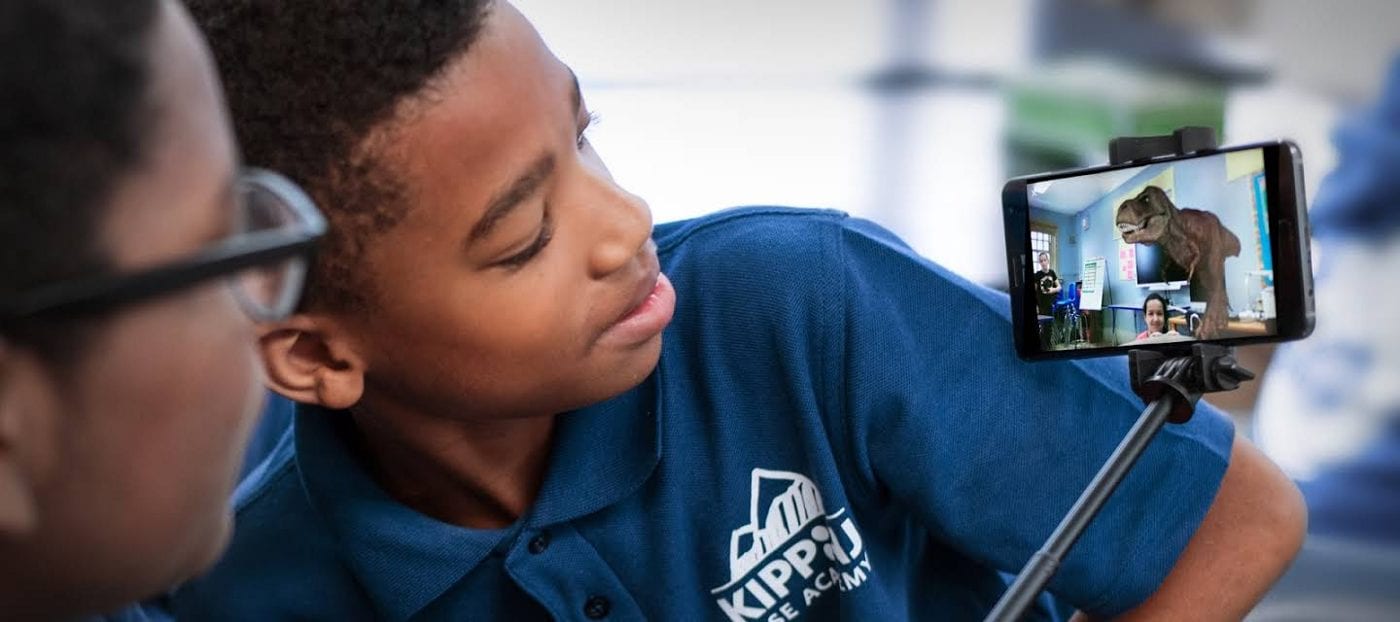Today, there is a new opportunity for every school to open a path to the future of learning. This opportunity is WebAR.
WebAR, browser based Augmented Reality, is a powerful new tool that can democratize access to the best educational resources using the device that nearly every elementary through 12th grade student has on hand today. WebAR only requires access to the internet and a mobile device with a camera on board. With one click, WebAR can break down the walls of books, classrooms, and physical resources, providing the best learning materials that are relevant and customizable for each student’s learning capabilities and culture.

Image credit: Playshifu
Through interactive education, immersive field trips and global democratization of access to education, WebAR has the potential to make a positive impact on student learning outcomes at every grade level and across every subject of study.

Image credit: The Human Anatomy Atlas app
Interactive Education
WebAR can appear in many forms such as 3D visuals, 3D animated content, 3D games and experiences, as 360 videos, or simply as graphic overlays, to name a few. Each of these experiences offers an interactive journey, where a student can observe content from multiple angles, discover new features and quizzes, and play games that increase engagement.
This type of active and innovative learning experience appeals to multiple learning styles, and is far more effective than passive learning techniques. A study in the American Journal of Occupational Therapy reiterates that participants are able to recall more information when engaged in hand-on teaching when compared to a demonstration method, stating that, “the learning advantages of hands-on occupation are related to the enhanced sensory/perceptual experiences and the feelings of success that are characteristic of hands-on learning, as opposed to passive forms of learning.”*
For example, rather than a traditional passive lecture or solitary reading exercise, students can scan an image that launches interactive 3D WebAR content that highlights interesting facts about underwater creatures and their behavior along with high-quality 3D models, engaging animations, fun mini games and more.
Education that can be experienced in the same way that we interact with our 3D world means an education that students can relate to, understand, and remember.

Image: RosieReality
A Field Trip in the Pages
Hollywood has made a business of taking us to places and stories that would otherwise exist only in our imagination.
The most talented content creators have inspired real life movements and scientific breakthroughs. With WebAR, educational institutions now have access to the same power of digital media that can inspire younger generations with a global outlook.
WebAR content can take students where 2D book pages and videos can’t. Students can now explore the expanse of the known universe, visit planets, journey to the center of the earth, and teleport forward and back in time. The ability to access and interact with 3D content gives students the opportunity to imagine new horizons and opportunities, based on culturally relevant and eye opening content.
Some of you may recall the Magic School Bus, and the excitement of travelling through the human body to learn about anatomy in a fun and engaging way. WebAR takes this a step further, enabling interaction with 3D models with facts, quizzes, and animation to show the relationship between systems and the functioning of certain organs.
Discover the smallest forms of life on Earth, bring giant versions of microbes to the table-top, deep sea creatures to the surface of decks, and invisible particles to the visible spectrum, enhancing the educational process with lifelike material that would otherwise be impossible to witness.

Image Credit: SCINTILLA KREATIONS
Democratizing Access to Education
In developed countries, we still see enormous disparities in educational quality and access based on limited resources, and constrained availability of teachers. This isn’t because there’s a shortage of talent who are interested in teaching the young ones, but because these roles are often underpaid and under-resourced.
In this instance, technology companies are uniquely positioned to step in and empower learning for future generations by partnering with educational providers. By taking the first steps to bring AR to the youngest digital natives, kids will have an opportunity to grow up with every resource they need to set them up for success. An augmented digital tutor can assist students while children are physically separated from classrooms, and parents are telecommuting, during this prolonged pandemic.
In underdeveloped countries, we face a similar crisis, on a far greater scale. There is a lack of access to resources, qualified educators and culturally relevant material. WebAR can provide a solution that is low cost, customizable to learning levels, scalable, easy to update, environmentally friendly, collaborative, language friendly, culturally relevant and shareable.
WebAR is not intended to replace teachers and classrooms, but to enhance teaching capabilities, track progress, and identify students who may be struggling at an early stage. It’s a portal to a new era of education that is more inclusive, connected, and meaningful to each student and teacher.

Photo Cred: Google, Expeditions App
Committed to Our Future
COVID-19 is accelerating the adoption of technology and toolsets for remote collaboration at unprecedented rates. It’s given us an opportunity to take a step back, and realize we are not alone in going through these challenges and adjusting to a new norm.
Most importantly, interactive augmented reality experiences impact the way that we engage with and process digital content. It calls for us to become active participants rather than passive consumers, opening our eyes to how content affects us, providing a window into the narrator’s world, and an opportunity to grasp the value of the information that is being shared.
More and more of our time is spent consuming television, podcasts and streaming videos, and WebAR offers a spatial computing bridge between the digital and physical worlds, a tactile interactivity that can enrich our relationship with new and old technologies.
If you have any questions about WebAR for education and want to explore how it can become a part of the solution to global access to education, don’t hesitate to reach out to our team at contact[at] geenee [dot] me.
Goals
Whether on high spec gaming laptops or mobile phones, gamers and sports bettors are some of the most active online audiences. Equally so, gamers are dedicated to their audiences, with top gamers such as Ninja, a Fortnite player, streaming up to 12 hours a day, and raking in over 500K a month from donations, subscriptions and sponsors.
Alternatively, gamers compete for cash prizes, with top players earning over 6M as they compete for the winning title, with training, salary and equipment fully backed by sponsors.
In this ecosystem that is founded on engagement, conversation and accessibility, the possibilities to explore web based augmented reality is endless. With the most receptive audience, there also comes the highest levels of expectations for digital content, and also some of the greatest loyalty to brands that support the players that fans love. If you would like to explore WebAR opportunities in esports with our team, you can reach us on LinkedIn.
Engage & Monetize Your Audience with Immersive WebAR Experiences
Be the first to try Geenee WebAR